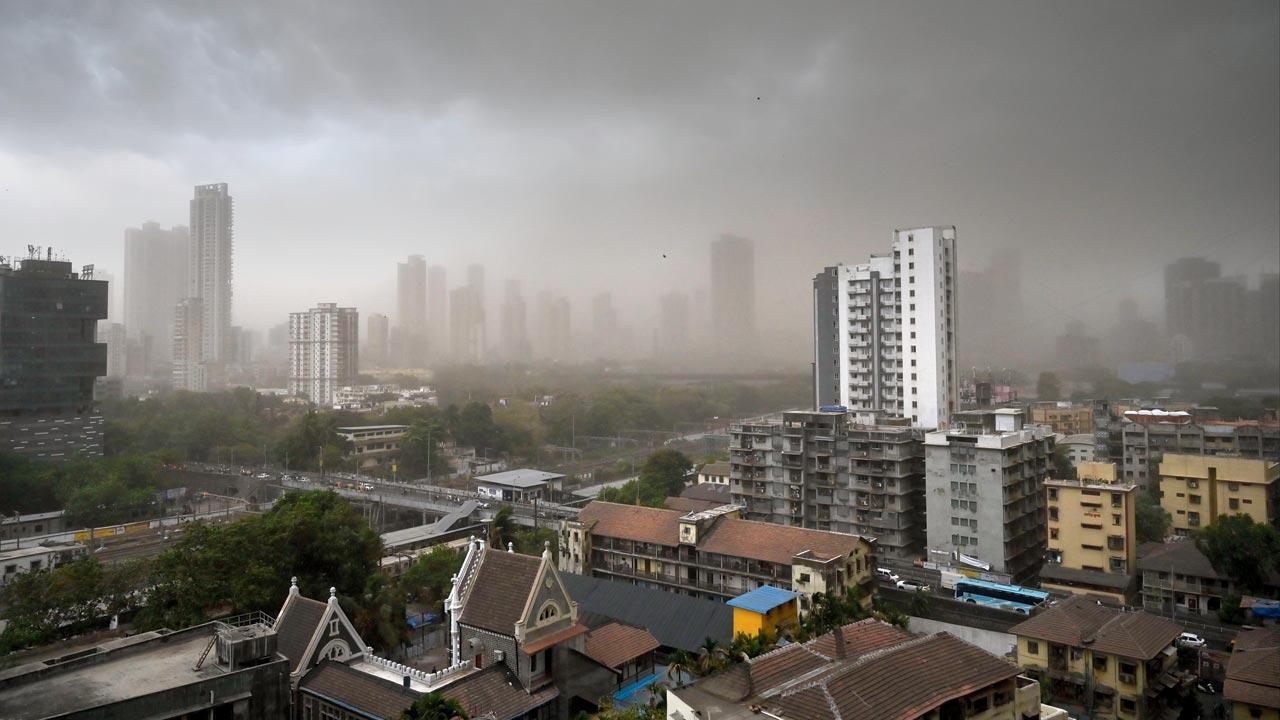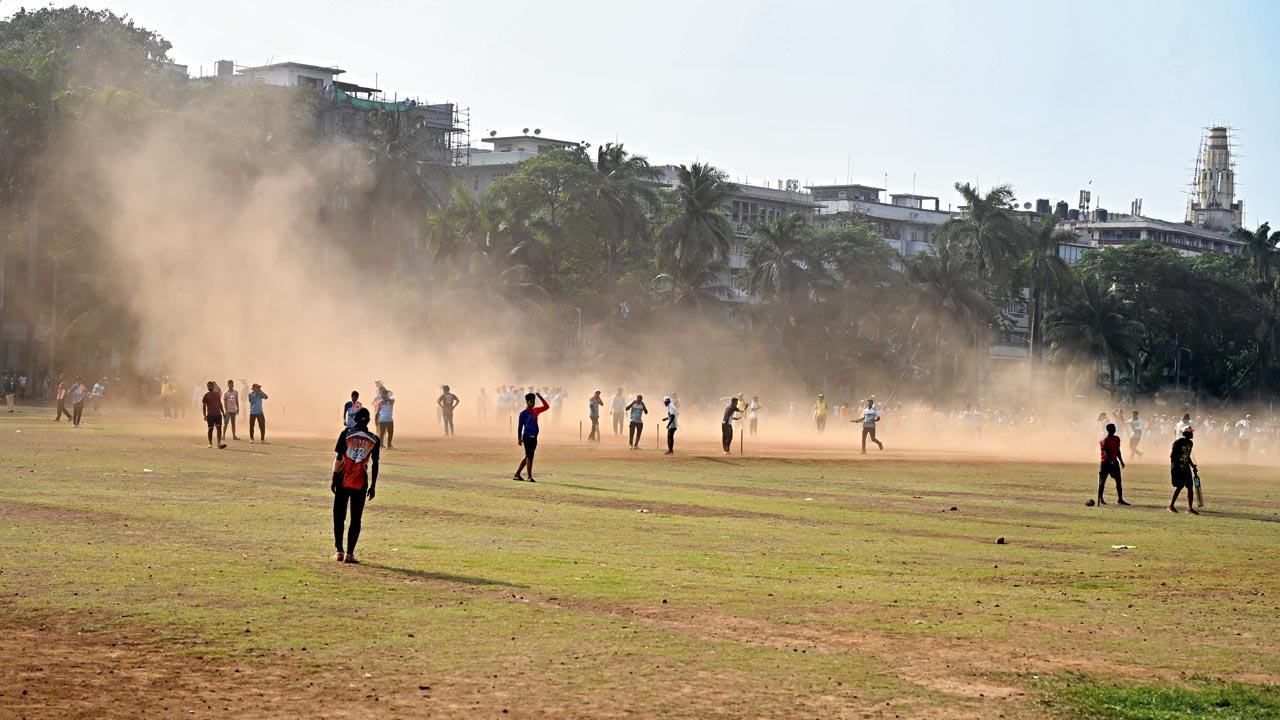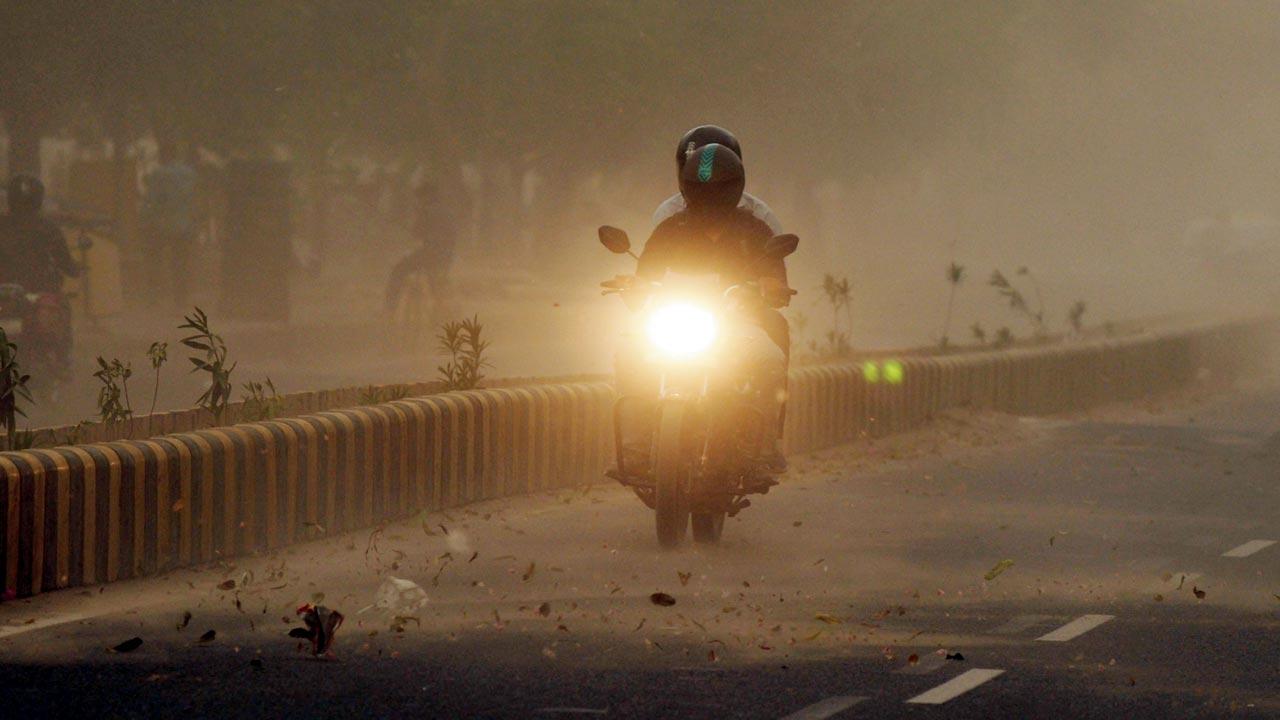Experts have referred to last week’s dust chaos as everything from ‘peculiar’, to ‘unusual’ and ‘urban heating’. What everyone agrees on is that this will now be regular and government hesitancy to re-engineer infra to suit climatic events may not cut it anymore

A dust storm-like situation enveloped the city’s skyline last week. This year, Moody’s RMS, a risk management company, says Mumbai’s risk mitigation costs will jump by 126 per cent. Pic/Getty Images
A little rain, wind and lightning isn’t enough to rattle the average Mumbaikar. We’ve seen it all—but on Monday last week (May 13) when funnels of wind and dust spiralled around us, we took notice.
Sunil Kamble, Director IMD (Indian Meteorological Department) Mumbai clarifies that though Monday’s visitor looked like a dust storm, it was just a thunderstorm with accessories. “As there was a lot of dust in the atmosphere, it mimicked a dust storm,” he explained. “A true dust storm is not accompanied by rains and continues over two to three days.”
The wind, speeding up to 80 kmph at some places and 65 kmph at others, picked up loose soil and dust, and took it along for a whirl.
In January 2022, dust storm swirled over Mumbai for three days. It was headed for Gujarat and Haryana, but took a surprising detour to the city (to try its luck in Bollywood, perchance?) and left Mumbai breathless.
 Cricket lovers at Oval Maidan playing right around the time that the thunderstorm this week. Pic/Atul Kamble
Cricket lovers at Oval Maidan playing right around the time that the thunderstorm this week. Pic/Atul Kamble
NASA’s Earth observatory said in its report: “A substantial dust storm enveloped the Arabian Sea. Plumes of desert dust affected populated areas around the basin, as winds carried the particles over Karachi, Mumbai, and numerous other cities and degraded air quality. Dust arose from three different countries but merged into a large plume that cast a pall over much of the Arabian Sea. According to Hiren Jethva, a Morgan State University scientist based at NASA’s Goddard Space Flight Center, the size of the plume was “quite remarkable,” as was its unusual path.”
The city’s AQI (Air Quality Index) hovered at Severe from January 21 to 23, the report adds.
Now recall how the end days in the sci-fi movie Intertellar begin with loose dust blanketing everything, and eventually killing babies off with respiratory diseases and crops too. To the point that finding a planet to flee to becomes a global priority. Apocalyptic?
Ach-tung.
 Dr Sunil Kamble, Lubaina Rangwala, Dr Mrutyunjay Mohapatra and Dr Anjal Prakash
Dr Sunil Kamble, Lubaina Rangwala, Dr Mrutyunjay Mohapatra and Dr Anjal Prakash
A report by the Asian and Pacific Centre For The Development Of Disaster Information Management (APCDDIM) called Sand and dust storm risk assessment in Asia and the Pacific found that in the year 2019, Mumbai saw dust concentrations higher than 50 µg/m3 which is categorised as Poor air quality.
Lubaina Rangwala believes lack of acceptance that extreme climate events in Mumbai have been increasing has resulted in the situation that left 16 persons dead and 174 injured this Monday. The urban planner and architect is Programme Head for Urban Development and Resilience with the Sustainable Cities and Transport team at World Resource Institute (WRI).“The BMC and all authorities will have to climate-proof all city infrastructure for all kinds of climatic events,” she says.
Rangwala feels that the deluge of 2006 revealed how unprepared the government is for natural disasters. “The 26/7 deluge was unprecedented, and this led to reviewing the Brimstowad Report to overhaul Mumbai’s stormwater management network. However over the years the city’s focus on disaster preparedness has been largely to combat floods,” she points out. ““We aren’t taking into account climate proofing our infrastructure for heatwaves, erratic (and more frequent) storms, landslides and other natural disasters.”
 Delhi experienced a thunderstorm around the same time as Mumbai. The timing has left many scientist wondering if there is co-relation. Pic/Getty Images
Delhi experienced a thunderstorm around the same time as Mumbai. The timing has left many scientist wondering if there is co-relation. Pic/Getty Images
On the Monday of the dust storm, the city recorded temperatures of 37.5 degrees, adding to the high moisture the city had been experiencing. A thunderstorm was inevitable, feels Kamble. “High temperature is the key ingredient in thunderstorms,” he says, “It is usual for Mumbai to experience thunderstorms, but yes, global warming and those high temperatures increased the forcefulness.”
However, not everyone thinks the end is nigh. Rajesh Kapadia, for one, who runs the weather forecast website, Vagaries. “I do not believe that [Monday’s storm] was due to climate change,” says the South Mumbai resident, “It was a normal thunderstorm, and the first of the monsoon. We had more thunderstorms in April last year. But I admit, Mumbai is facing the phenomenon of urban heating.”
This year Moody’s RMS, a risk management company that evaluates and manages risks of natural and manmade disasters, says the metropolis’ risk mitigation costs will jump by 126 per cent this year. This is due to heightened urban heat stress in a moderate emissions scenario. They came to the conclusion after analysing data collected in 2023: Simply put, the rising heat of Mumbai has increased the risk of the city experiencing a disaster by 126 per cent—natural
or man-made.
So what happened on Monday was nothing out of the ordinary? “It was peculiar,” admits Dr Kaustav Chakravati, Scientist at the Indian Institute of Tropical Meteorology, “Which is why we have made note of it. It isn’t that Mumbai has not experienced thunder or dust storms, but we are unable to understand what caused such high wind speed. We are currently examining the data and are likely to know more by next week.”
Chakravarty has been studying Mumbai’s extreme weather changes for the last decade or so. “The changes are sharp and dramatic, but we cannot for sure say that dust has increased. And about the particular event of Monday, it can only be described as a windy thunderstorm,” he says.
The lack of data is unmissable, a fact spotted by the In the executive summary of the same report ,it mentions, “Lack of data presented one of the most prominent challenges throughout the process of conducting this risk assessment. Several types of sand and dust storm hazard are poorly accounted for, and in-depth risk assessments for sand and dust storm events across multiple sectors at national and local levels are needed.”
Anjal Prakash, PhD, Clinical Associate Professor (Research) and Research Director of Bharti Institute of Public Policy, Indian School of Business, expresses that the thunderstorms are going nowhere. “The frequency of recent thunderstorms, like those observed in Mumbai on May 13, is expected to rise due to climate change. Warmer temperatures increase atmospheric moisture, fuelling more intense and frequent storms.” He furthers what an unstable weather pattern only gives impetus to storms. “Changing weather patterns and shifts in atmospheric circulation can contribute to the amplification of thunderstorm activity in certain regions. Urbanisation and land use changes may also play a role in altering local weather patterns. Combined, these factors indicate a likelihood of more frequent and intense thunderstorms in the future, posing challenges for urban infrastructure and resilience efforts,” he adds.
Have and can civic infrastructure do anything against the weather that is erratic and hits us without any warning? Maybe we can, says Prakash, “Civic authorities can enhance infrastructure resilience to high wind speeds through stringent building codes, wind-resistant construction techniques, and retrofitting existing structures. Incorporating green infrastructure and advanced stormwater management systems mitigates wind impact and prevents flooding.” Another vital gap in our current preparedness seems to be the gap in agencies and lack of public awareness. “Advanced warning systems and public education promote preparedness and reduce risks.
Collaboration with meteorological agencies and neighbouring municipalities facilitates coordinated responses. Investing in research, resilient projects, and community engagement fosters long-term adaptation. By combining engineering solutions, policy interventions, and community involvement, authorities can bolster infrastructure against high winds, minimising the impact of severe weather events for safer and more resilient communities,” he adds.
Mrutyunjay Mohapatra, Director General Meteorology at IMD, says the instability of the atmosphere, and transfer of dust from Saudi Arabia and Oman have contributed to India’s greatest dust storms. “But in Mumbai, the thunderstorm [on Monday] was due to an unstable atmosphere,” he says. “Dust and thunderstorms are not so frequent in Maharashtra. We cannot blame climate change because it was random, and it’s hard to pinpoint a trend.”
However, Mohapatra does agree that the rise in temperature does increase frequency and intensity of thunderstorms. “But that doesn’t mean that Mumbai will see an increase in them; again it is hard to pinpoint a trend,” he reiterates.
But Rangwala holds firm: “We need to assume that this is not a one-off event, and work towards a holistic plan to address infrastructure vulnerabilities to increasing climate risks. Having an all weather-proof.”
Nature’s death toll
The National Crime Records Bureau (NCRB) 2022 report on accidental deaths and suicides in India revealed that in 2021, 8,060 accidental deaths were caused by forces of nature such as lightning, heat stroke, exposure to cold, floods, landslides and torrential rains.
 Subscribe today by clicking the link and stay updated with the latest news!" Click here!
Subscribe today by clicking the link and stay updated with the latest news!" Click here!










